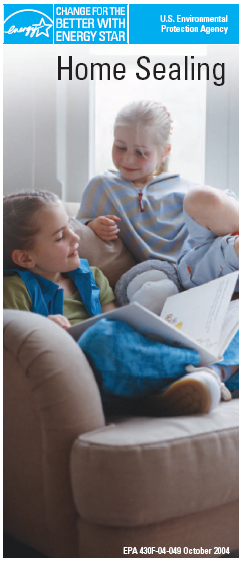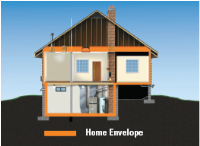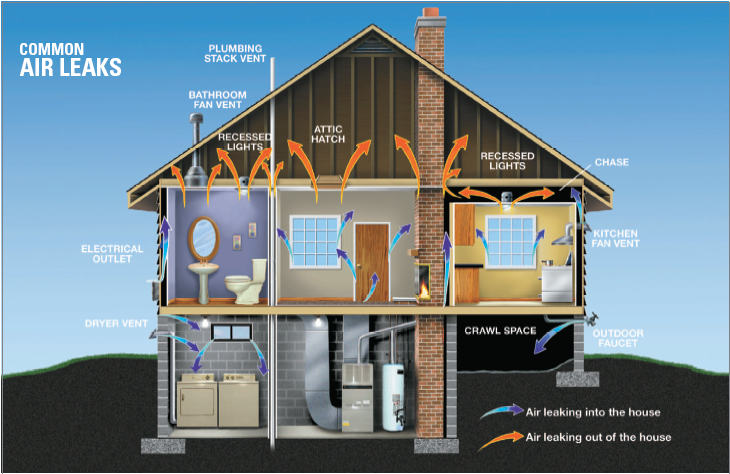 What is Home Sealing? What is Home Sealing?
Home Sealing is a process recommended by EPA to help increase the comfort and energy efficiency of your home by improving the “envelope”—the outer walls, ceiling, windows, and floors.
To improve the envelope of your home:
Seal air leaks to stop drafts and get full performance from your insulation;
Add insulation to stay comfortable during periods of extreme temperatures; and
Choose ENERGY STAR qualified windows when replacing old windows.
THE BENEFITS OF HOME SEALING
Sealing air leaks and properly installing insulation in your home has many benefits:
-
Improved comfort during winter and summer;
-
Lower energy use which means lower energy bills;
-
A quieter home with less noise entering from outside;
-
Fewer holes for pollen, dust, pollution, and insects to enter the home; and
-
Improved durability by reducing movement of moist air through the building structure. U.S. Environmental Protection Agency
Effective air sealing, combined with the right amount of insulation, can make your home more comfortable and cut heating and cooling costs by up to 20%.
Improving Your Home Envelope
The exterior of your home is called the "envelope" or "shell". (See the orange line showing the envelope in the diagram at right.) The envelope is made up of the outer walls, ceiling, windows and floor. Improving your envelope can make your home more comfortable, especially under extremely hot or cold conditions, and help lower your energy bills.
HIDDEN AIR LEAKS
Air leaks can make your home uncomfortable. In the winter, drafty windows and doors, cold walls or ceilings, and ice build-up or ice dams on the roof are all symptoms of air leaks or poor insulation in the attic. In the summer, ceilings that are hot to the touch and upstairs rooms that are uncomfortably hot , no matter how low the A/C is set, can also be a sign of air leaks and insufficient insulation.
Fixing air leaks can make your home more comfortable and help you get full performance from your insulation and your heating and cooling system. (See the house diagram below showing common air leaks.)
If you add up all the hidden air leaks in your home, they can equal a hole the size of an open window—and can lead to a higher energy bill.
There are many ways to fix air leaks, such as caulking, using spray foam, and weather stripping for closing smaller cracks and gaps. Plywood, drywall, and rigid foam insulation may be used for plugging larger holes. Sheet metal and high-temperature caulking can be used to close gaps around chimneys and furnace flues.
 INSULATION
Adding insulation can reduce the amount of energy it takes to heat and cool your home and can help provide consistent comfort in every part of your home, especially when the outside temperatures are the most extreme. The most common types of insulation are cellulose, fiberglass, rigid foam, rock wool, and spray foam. And remember it is important to seal air leaks before adding insulation.
ENERGY STAR QUALIFIED WINDOWS
Windows are an important part of the home envelope. If you are remodeling or building an addition, consider replacing old windows with models that have earned the ENERGY STAR. They can make you feel more comfortable, reduce UV damage to interior fabrics and can cut home heating and cooling costs.
HOW TO GET STARTED
For the best results, EPA recommends working with a home energy professional and/or insulation contractor in your area. For recommendations on finding a contractor visit www.energystar.gov/homeimprovement. These professionals offer a range of services—everything from testing your home and identifying areas for improvement to actually making the energy-saving upgrades.
After air sealing, be sure to have a professional check your home’s ventilation and test combustion appliances to be sure they are properly venting.
For “handy” homeowners, there are do-it-yourself measures that you can take to improve your home’s envelope. Sealing air leaks hidden in the attic and basement and adding insulation in the attic are low-cost, easy ways to improve the comfort and energy efficiency of your home yourself.
Source: U. S. Environmental Protection Agency
|